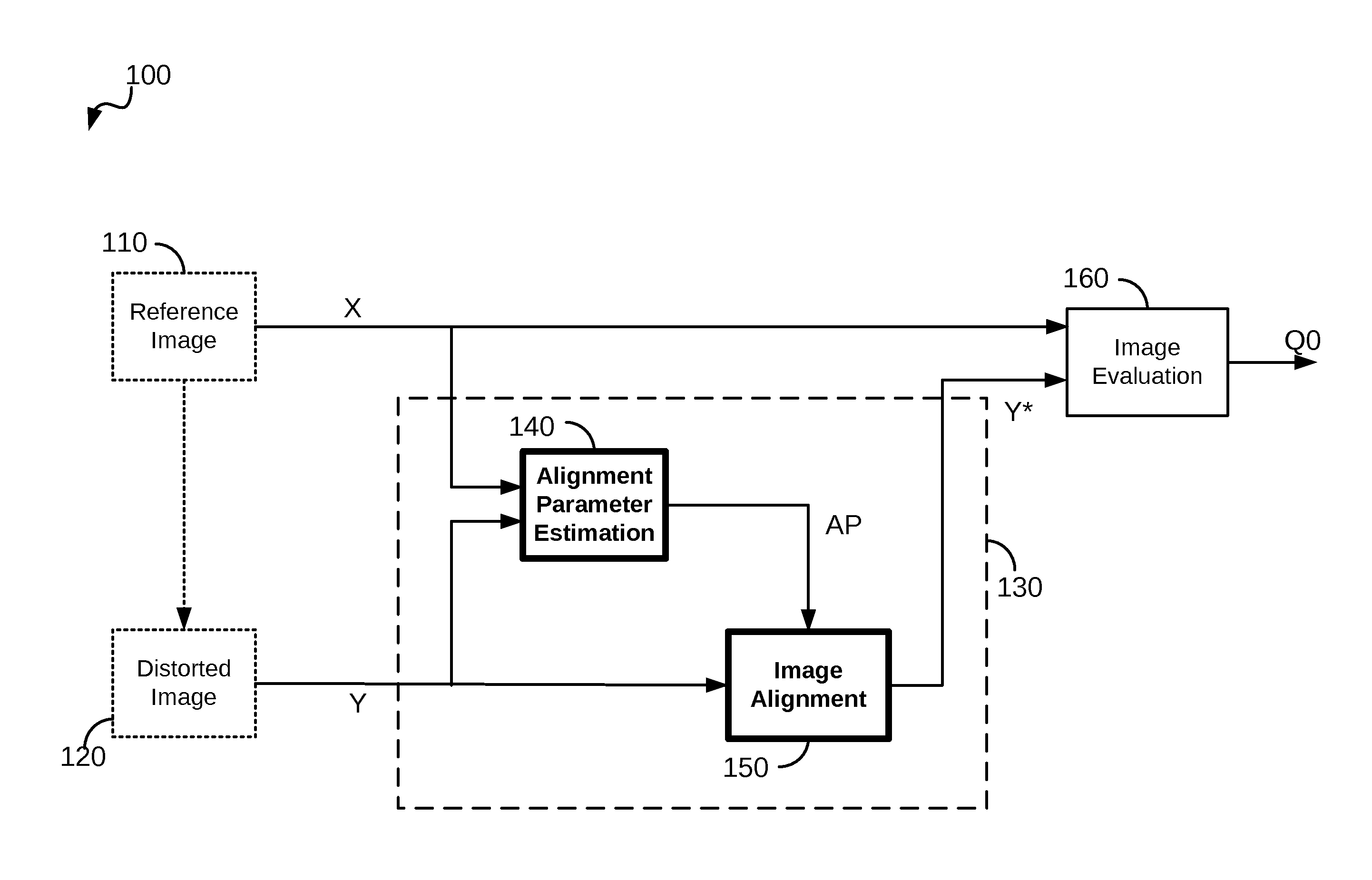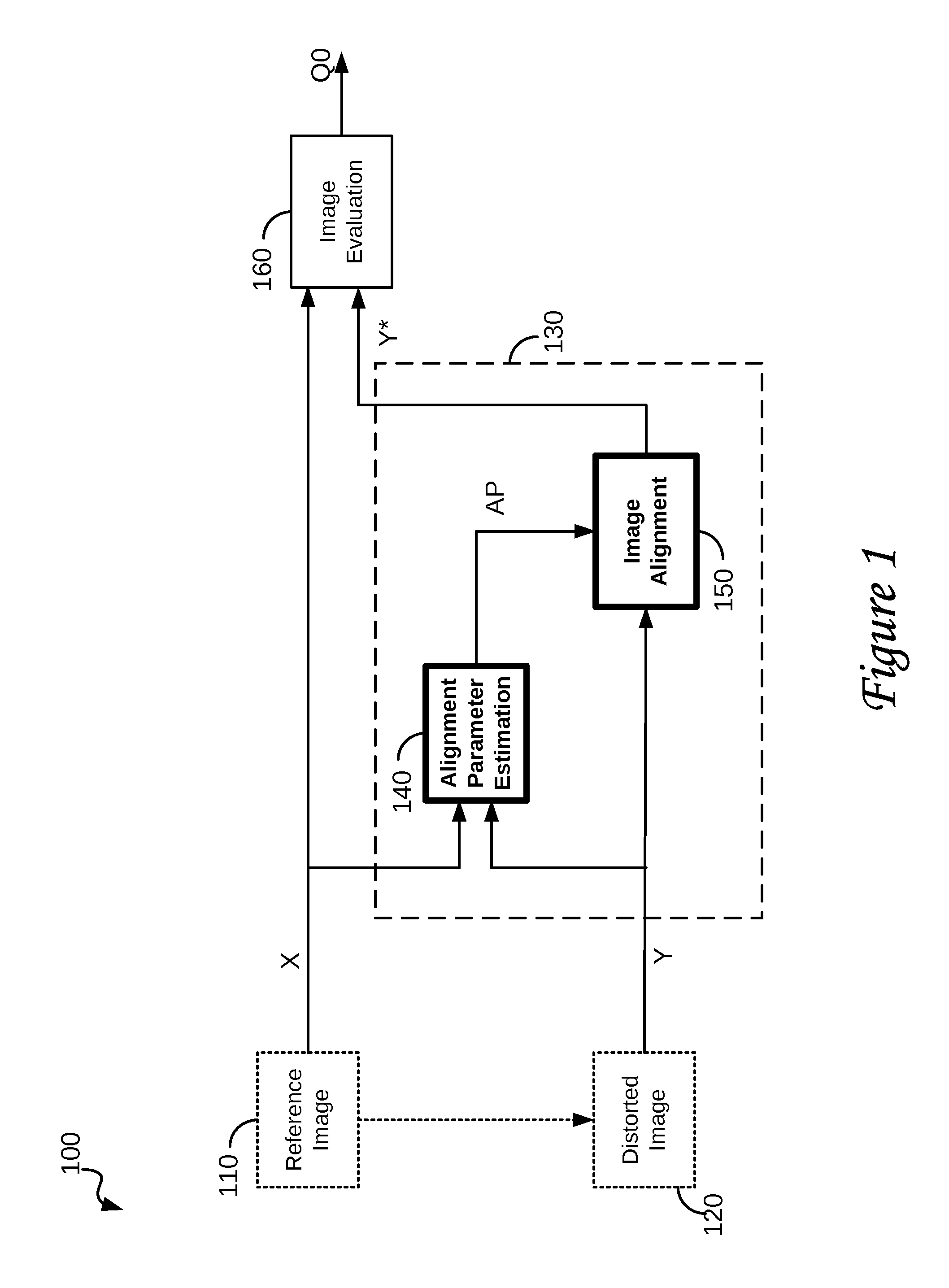Image registration method and system robust to noise
a technology of image registration and noise, applied in the field of digital image processing, can solve problems such as methods failing, and achieve the effect of improving image registration methods and systems
- Summary
- Abstract
- Description
- Claims
- Application Information
AI Technical Summary
Benefits of technology
Problems solved by technology
Method used
Image
Examples
first embodiment
[0126]the Image Pre-processing system 130 is based on:[0127]extracting sets of keypoints from both the Reference Image X and the Distorted Image Y;[0128]matching a selected number of pairs of keypoints from X and Y that are closest;[0129]solving for parameters of a first affine transform;[0130]generating a second affine transform which is an inverse of the first affine transform;[0131]applying the second affine transform on the Distorted Image Y, thereby generating the Pre-processed Image Y*.
[0132]A keypoint is known as a Scale Invariant Feature Transform (SIFT) parameter set that was proposed by D. G. Lowe in “Distinctive Image Features from Scale-Invariant Keypoints,” International Journal of Computer Vision, vol. 60, no. 2, pp. 91-110, 2004, to characterize a distinctive area in an image. Two specific implementations of the Alignment Parameter Estimation process 140 and corresponding implementations of the Image Alignment process 150 are proposed.
[0133]FIG. 2a shows a block diagr...
second embodiment
[0141]FIG. 2b shows a block diagram of an alternative Affine Transform based image alignment system 200.2 which is the Image Pre-processing system 130. The alternative Affine Transform based image alignment system 200.2 of FIG. 2b provides the same functionality as the Affine Transform based image alignment system 200.1 of FIG. 2a, with the exception that the Transform Inversion module 280 and the Affine Image Transformation module 220 are combined into a single, more efficient, Affine Compensated Image Generation module 290.
[0142]FIG. 3 is a flow chart of an affine transform based realignment method 300 according to the first embodiment of the invention, including steps:[0143]310“Zero Pad Image(s)”;[0144]320“Extract Key Features”;[0145]330“Match Keypoints”;[0146]340“Number of Matching Pixels[0147]350“Estimate Affine Parameters”;[0148]360“Invert Transform”;[0149]370“Perform Affine Transform”;[0150]380“Generate Affine Compensated Image”; and[0151]390“Fill Blank Pixels”.
[0152]Let the ...
third embodiment
[0206]FIG. 15 is a block diagram of a first Radon Transform based image alignment system 1500 which is the Image Pre-processing system 130 of FIG. 1, comprising the following modules:
a Scaling Factor Estimation module 1502 for determining the scale factor “a”;
an Image Masking module 1504 for extracting a masked image Y0 from the Distorted Image Y;
a Centroid Computation module 1506 for determining centering parameters “cr” and “cc” from the masked image Y0;
an Image Centering module 1508 for centering the Distorted Image Y and generate a centered image Y1 using the centering parameters “cr” and “cc”;
and
an Image Resizing module 1510 for resizing the centered image Y1 into a resized Distorted Image Y2 using the scale factor “a”.
[0207]The resized Distorted Image Y2 is of the same size as the Reference Image X and has been centered, but may still need to be rotated.
[0208]The first Radon Transform based image alignment system 1500 further includes:
a Rotation Angle Determination unit 1511 c...
PUM
 Login to View More
Login to View More Abstract
Description
Claims
Application Information
 Login to View More
Login to View More - R&D
- Intellectual Property
- Life Sciences
- Materials
- Tech Scout
- Unparalleled Data Quality
- Higher Quality Content
- 60% Fewer Hallucinations
Browse by: Latest US Patents, China's latest patents, Technical Efficacy Thesaurus, Application Domain, Technology Topic, Popular Technical Reports.
© 2025 PatSnap. All rights reserved.Legal|Privacy policy|Modern Slavery Act Transparency Statement|Sitemap|About US| Contact US: help@patsnap.com



